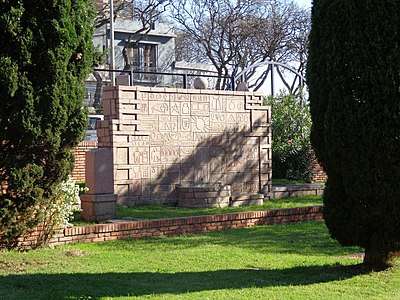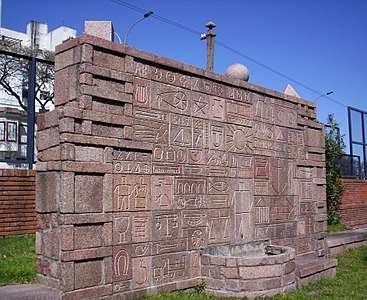Joaquín Torres-García
| Joaquín Torres García | |
|---|---|
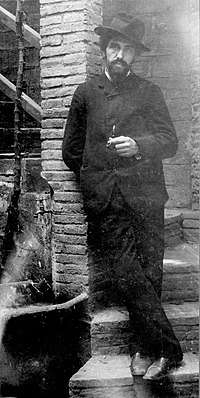 Joaquín Torres García, 1903, at the Sagrada Familia, Barcelona | |
| Born |
Joaquín Torres Garcia 28 July 1874 Montevideo, Uruguay |
| Died |
8 August 1949 (aged 75) Montevideo, Uruguay |
| Nationality | Uruguay, Spanish |
| Education | Escuela Oficial de Bellas Artes Barcelona |
| Known for | Painter, Sculpture, Writer, Teacher, Illustrator, Theorist |
| Movement | Modern Art, Noucentisme, Constructivism |
| Website | https://jtorresgarcia.com/ |
Joaquín Torres García (28 July 1874 – 8 August 1949) was a Spanish Uruguayan artist painter, sculptor, muralist, novelist, writer, teacher and theorist, active in Spain, United States, Italy, France and Uruguay.
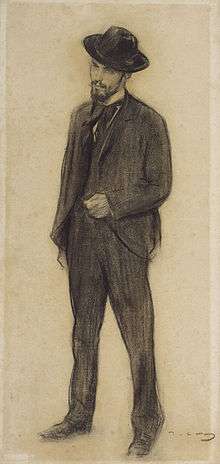
Torres Garcia was an avant gardist whose influence encompasses European, American and South American modern art.[1][2] He dealt the eternal dilemma between the old and the modern, the classical and the avant-garde, reason and feeling, figuration and abstraction with a simple and brilliant metaphor: there is no contradiction or incompatibility. The same brush strokes serve for a primitive composition or for a mural of Renaissance inspiration. Like Goethe, he seeks the integration between classicism and modernity.[3]
He is known for his collaboration with Gaudi in 1903 on the stained glass windows for the Palma Cathedral[4] and the Sagrada Família.[5] He decorated with monumental frescoes the medieval Palau de la Generalitat seat of the Catalan government.[6] His art is associated with archaic universal cultures; Mediterranean cultural traditions, Noucentisme, and Modern Classicism. From 1920 he developed a unique style, encompassing Cubism, Dada, Neo plasticism, Primitivisme, Surrealism, Abstraction and coined the term Universal Constructivism.
As a theoretician he published more than one hundred and fifty books, essays and articles written in Catalan, Spanish, French, English; "admirable treaties on aesthetics and avant-garde literature."[7] In his lifetime he gave more than 500 lectures. An indefatigable teacher who founded several art schools one in Spain and another in Montevideo and numerous art groups including the first European abstract art group and magazine Cercle et Carré (Circle and square) in Paris in 1929.[8] Among the many artists that have called him "Maestro" (teacher) are Joan Miró, Helion, Pere Daura, Engel Rozier.
Retrospectives in Paris in 1955 and Amsterdam in 1961 are the earliest to document historically the place of Torres-García in the currents of abstract art. In the United States he had important exhibitions in the 1920s, in the 1930s at Gallatin's Gallery of Living Art as a master of the European Modern Art with Arp, Braque, Gris, Picasso.
Sidney Janis Gallery and Rose Fried Gallery sponsored important shows from the 1950s.
Biography
1874–1900
Joaquín Torres-García was born in Montevideo, Uruguay on 28 July 1874. The first child of Joaquim Torras Fradera (son of Joan Torras and Rosa Fradera), an emigrant from Mataró, Spain, and María García Pérez (daughter of José María García, from the Canary Islands, and Misia Rufina Pérez, Uruguayan). He grew up in his father's general store called the Almacen de Joaquín Torres.[9] As a child, Torres "examined the picturesque store situated in the old Square of the Wagons, the arrival point of the raw material of the country for export to Europe. The colonial Montevideo had a port, trains, and a vibrant population dotted with countless gauchos wrapped in capes with whip ready in hand."[10] "Much of his early education in that predominantly agricultural society came from his observation of the things around him ... He received his first formal art training when his family returned to Spain"[11]
In 1891, Torres-García's father returned to Mataró, Spain, with his wife and three children who became naturalized citizens of Spain ("l'artista uruguaianocatalà Joaquim Torres Garcia")[12]. He studied with a local painter. He soon showed a strong vocation. The family moved to Barcelona. Torres-García enrolled in the School of Fine Arts in Barcelona (Escuela de Bellas Artes de Barcelona), the Baixas Academy (Academia Baixas) and the Saint Lluc Artists Circle.[13] "Torres-García and Picasso were contemporaries. Both began their artistic lives in modern Barcelona... whose privileged epicenter was the cafe Els Quatre Gats...The language came from Paris; the favorite models were Toulouse-Lautrec and Steinlen."[14] His classmates and friends included Ricard Canals, Manolo Hugue, Joaquim Mir, Isidre Nonell, Pablo Picasso, and Julio Gonzalez. Torres assiduously contributed drawings in all the principal newspapers and magazines of the time: La Vanguardia, Iris, Barcelona Cómica and La Saeta.
In 1900, Torres Garcia's father died.
1901–1909
Miguel Utrillo wrote an article titled "Joaquin Torres-Garcia, Decorator" in Pel i Pluma, published with a portrait by Ramon Casas, photographs of several paintings by Torres — one on the cover of the magazine — and his first article, called "Impressions".[15]
Antoni Gaudí commissioned Torres in 1903 to create stained-glass windows for Palma Cathedral. "One of the key events in his career was his intervention (between 1902 and 1905) in the High Altar of the Cathedral of Palma de Majorca, a masterpiece of Spanish Gothic, for which he made the lateral stained glass windows and the small rose window in the apse. His interpretation, of the Marian symbols ... from the Song of Songs — in the words of Baltasar Coll Tomas — is one of the many dialogues proposed by Torres ... these symbols ... will be reinterpreted in every stage of Torres's long career: the sun, the moon, the star, the well, the garden, the tower, the temple. ."[16] Commissioned murals for Church of San Agustin, Church of the Divina Pastora, and the house Torre del Campanar.
Eugeni d'Ors, the intellectual father (and inventor of the term) noucentisme, praised artworks that Torres Garcia shows at Sala Parés and the Cercle de Sant Lluc that same year. Later will write the prologue to Torres' show in the Galeries Dalmau in 1912 and includes frequent references of Torres's work in La Ben Plantada, the book which summarizes the ideology of the noucentista. But Torres is far from being an adherent of the ideology indicated by D'Ors; his evolution follows his own theoretical elaboration, explicit already in two texts published before the configuration of noucentisme as a trend around 1910: "Augusta et Augusta" (1904) and "La nostra ordinacio I el nostre cami" (1907). In Classicism, Torres searches for model of order, a language and an adequate cultural reference to overcome the realistic tendency of representation and to develop a Catalan art of capable of universal proportions. Objective which coincides with noucentisme, but Torres's radicalness paradoxically separate him from artists who follow this tendency — Sunyer, Canals, Aragay — and ultimately D'Ors.[17]
Torres-García began teaching art in 1907 and "gradually became involved with an experimental school Colegio Mont d'Or founded by his friend the progressive educator Joan Palau Vera. Contrary to the academic expectations of the day, at Mount D'Or here were no copies from casts, prints or books; drawing went directly to reality: all the common objects of the house from the kitchen to the laboratory were paraded in front of students, as well as leaves, fruits, fish, flowers, animals. The vocabulary of universal constructivism was being developed as an exercise in progressive pedagogy."[9]
In 1909, he married Manuela Piña i Rubíes, a Catalan, with whom he would have four children.
1910–1919
Torres-García traveled to Brussels to paint a Pavilion in the Brussels International World Fair. During this prolonged stay in Paris, he visited friends, museums and galleries. Though different, his art would later share values with Cubism and the theories exemplified in Du "Cubisme" (published in 1912), and revealed in the exhibition organized and named by a group of artists: Section d'Or, in Paris (1912).
On his first trip to Italy and Switzerland, Torres-García observed the ancient and the modern: futurism.
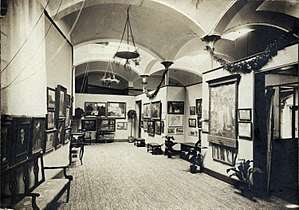
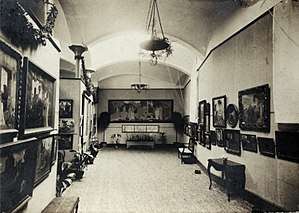
In 1911 he exhibited in the VI International Exhibition of Art in Barcelona the iconic painting "Philosophy X Musa" which he donated by request of Prat de la Riba to the Institut d'Estudis Catalans were it still is today. "From the moment of its public appearance until today this work has been unanimously interpreted by the historiography as the foundational reference of noucentisme."[3] Painted a second version of this painting which today is part of the collection of the Reina Sofia Museum in Madrid.
In 1912 two exhibitions took place at the Galeries Dalmau: Joaquín Torres-García, with works from his Noucentista period; and Pablo Picasso, drawings from his Blue Period (February - March 1912).[18][19][20]
In May 1913, he published his first book, Notes sobre Art (Notes on Art). In the introduction he writes "Aquestes curtes notes poden tenir interès, demes, per anar estretament lligades, com quelcom de viu, a tot o que arrencant de la nostra tradició, en el pensament i en la realitat, tendeix a formar el ver Renaixement e Catalunya" (These short essays may be of interest also because they are closely related to, something that is alive, sprung from our tradition, in thought and in reality, to form the true Renaissance of Catalonia). Founded the Escuela de Decoración (School of Decoration/Decorative Arts) in Sarrià. "Prat de la Riba had then his newly formulated conception of Catalan nationalism, and sees in the Mediterranean tradition proposed a positive content for the national profile, rich in spiritual substance. Prat de la Riba protects the painter and commissions the famous frescoes of the Deputation."[21]
In 1913 he began to create murals for the decoration of the monumental atrium of the Municipal Palace of Barcelona.[22] "Today the work of the Palace of the Generalitat of Catalonia is fortunately preserved faithfully in its most substantial core to its original architecture. It was not, however, until 1907, when Enric Prat de la Riba became chairman of the council, which began an important period dedicated to exalt building, parallel to the resurgence of the national political structure. ... Also began a series of mural paintings at the Salon Sant Jordi, an important work by the Uruguayan Catalàn artist Joaquim Torres-García, remaining unfinished at the death of Prat de la Riba in 1917, going beyond the utilitarian and decorative to become the new symbol of the Catalonia noucentista."[23]
He designed, built, and decorated with frescoes his home in Tarrasa, "Mon Repos" and invites friends and pupils to an inauguration party.[24]
"For the next five years, he planned and executed murals in fresco technique, employing an "Iconostasis" composition, applied to a "pagan" subject matter and then to a modern theme, proving that classic is not solely associated to the Greek. He painted with orthogonal lines the rhythms of the structure used. This was an evolution he described in "El Descubrimiento de si mismo", and in the manifesto "Evolucionista" published in 1916. Torres-García would later use this same composition in his "Constructivist" works." What may be seen as a break in style of the figurative classical theme to the vibrant collage of images of "new" work is rather a deepening understanding the artist has for his work. " In one of the frescoes ...Torres-Garcia represented a gigantic Pan-god with a quote from Goethe's 'Faust' at his feet: 'The temporal is only a symbol'. "That is the key to all the poetics of Torres-García, the will to surrender to the ephemeral in order to reach eternity," explained Llorens. For Torres-Garcia, classicism was the door of a better future, not a brake for modernity."[25]
In 1918 "Torres-García can be seen exploring the grid structure,' on the one hand as an inherent characteristic of a modern city and on the other as a form to explore the symbolic potential of everyday motifs. He also explored the potential for language within images, as in the 1916–17 drawing 'Descubrimiento de si mismo (Discovery of Oneself)."[26] Exhibition at Galeries Dalmau of "Joguines d'Art (Artistic Toys)". "The toys teach children which are the correct colors, the correct forms. Each toy is a form, a color that mixes with other shapes and colors and finally becomes a whole: a dog a car a city. The toys guide future generations to acquire a natural eye."[27]
In 1919, Josep Puig i Cadafalch, the new president of the Mancomunitat cancelled the decoration Saló de Sant Jordi, in the old Palau de la Generalitat. Torres-Garcia decided to visit United States for a couple of years. "he determined to take the pulse of the greatest and most modern of cities, New York."[9] " despite being one of the most important artists of the moment, Torres García did not lull, and in 1920 he went to New York to continue exploring what they called modernity, and began to cling to the ephemeral and temporal, what he drew in the city of skyscrapers connects with what John Dos Passos reflected in Manhattan Transfer."[28]
1920–1929
Departs a second time for Paris, with thirty-two crates of paintings. After an encounter with his friend Picasso, who advised him not to leave Paris; "do not to go to America, because it will be like leaping into a void". His work turns from classicism to Cubism, while Picasso's from Cubism to classicism.[29] Seeking to experience a modern city, he travels to New York with the intention of staying two years. He lived at 138 West 49th Street, then 14th Street on the very day he became 46 years old. Shortly afterward at 4 West 29th Street, between Broadway and Fifth Avenue. Full of enthusiasm, he continued his series of book of sketches of cities he visited. He reflected symbolically the movement and atmosphere of New York. Paints a series of portraits, including one of Joseph Stella. The vertical city enhances the orthogonal structure of his cityscape. He works at painting scenery and costumes of The Great Way, a story of the joyful, the sorrowful, the glorious. In 1922 he exhibits at The Whitney Studio Gallery[30] and the Society of Independent Artists together with Stuart Davis and Szukalski. He described his work as "expressionistic and geometric at the same time, and very dynamic".[31]
He returns to Italy in 1922. Further development of his Classic and Evolutionistic works. Spain forbids Catalan language, among which Torres-Garcia's writings are included. Death of his mother. In 1925 settles in France, Villefranche-sur-Mer. In 1926 he has another solo exhibition at Galeries Dalmau in Barcelona.[32]
Moves to Paris for the third time.[29] Throughout the next six years Torres becomes one of the principal animators of abstraction movement between the wars. An ample movement integrated by young artist of several European countries and from 1930 based mainly in Paris and organized in three movements Abstraction-Creation and Cercle et Carre.[3] Exhibits 34 works, a series of large classical nudes and paintings from New York at Galerie A. G. Fabre. "Forty works make up this presentation of Torres-Garcia first exhibit here at Galerie Fabre: frescoes, fragments of large murals, assembled architectural maquettes, still life or figures ...They show the artist under different aspects manifesting all the fiery wealth and complex diversity. Some urban landscapes will give an idea of the passage of Torres-Garcia by New York were feverish spectacle of the business city captivated some time his artistic inquietude in search of its rhythm. Although he has played a major role in the development of the Mediterranean school, Garcia is bent with such a force towards his personal inclination he has always cleared away from the prejudices of isms (schools) that might limit his personal growth"[33] "However, by returning to the Classicism of his early work he made it clear that this was not an artistic language he had sought to vanquish through abstraction".[26] May 1927 group show with Stanislaw Eleszkievicz and Runser at Galerie d'art du Montparnasse. Solo exhibit of paintings at Galerie Carmine, "Quelques Peintures" 16 to 30 June 1927.[34] Solo exhibit at Galerie Zak in December 1928. Group exhibition in Galerie des Editions Bonaparte with John Graham, Kakabadze, Tutundjian, and Vantongerloo in August 1929. Solo exhibit in Galerie Carmine. As correspondent for the Catalan literary magazine Mirador, writes series of articles on painters including an interview of Georges Braque. 'But if Mondrian wanted to explore modernity by a single path, he (Torres-Garcia) wanted to get to the bottom by two paths at the same time, starting from reason but not avoiding intuition'[28]
1930-1939
The structural familiarity of the neoclassical works of the years 1912-1916 with the constructive works of the early thirties is surprising since it contradicts the general opinion shared by critics and historians, that access to constructivism meant for Torres a conversion to neoplasticism produced by a kind of Parisian contagion.[35] Torres finds system between representation and abstraction by the use of signs.[35]
In 1931 he has two solo exhibits at Galerie Jeanne Bucher and Galerie Percier, in October a group show at Georges Petit with Giacometti, Ozenfant, Max Ernst, Miro, Salvador Dalí .[36] In 1932 a solo exhibit at Galerie Pierre of paintings and sculptures. "The friendship between Van Doesburg and Torres-Garcia will create the foundations for the three most important movements to promote abstract art: "Cercle et Carre" (1929–1930), "Art Concret" (1930); and "Abstraction-Creation"(1931–1936)."[3] ".. he founded the magazine Cercle et Carre with Theo Van Doesburg, and with many difficulties assembled a group of 80 artists who exhibited in No. 23 rue de la Boetie."[10]
Leaves for Madrid. Finishes the manuscript of "Arte Constructivo" published in 1935 with under the name "Estructura", dedicated to his friend Piet Mondrian. Teaches and lectures.
April 1934 at sixty returns for the first time since childhood to Montevideo. In August exhibit of paintings and sculptures and also exhibits the work of the "Cercle et Carre" group from his personal collection and reedits the magazine as "Circulo y Cuadrado" to stimulate his students.[29] As he did in Barcelona he now shapes the artistic education of Uruguay, Argentina, Brazil and Chile. In 1937 publishes autobiographical novel "Historia de mi vida (Story of my life)" writing from the third person point of view. "He begins work in "Monumento Cosmico" One of his most representative worksfrom this period. Constructed from pink granite from near by quarries."[29] 1939 designs the "Monumento Cosmico" build and etched under his directions in granite. Paints a series of portraits under the name of "Men, Heroes and Monsters ".
1940-1949
Announces closing of school Association of Constructive Arte when he made last of 500 lectures he gave between the years 1934-1940. In 1941 publishes "Ciudad sin Nombre (A city with no name)". In November solo exhibition at Society of Architects of Uruguay. In July 1942 receives a visit from Lincoln Kirsten curator for the Comity of Inter-American Relations and Nelson A. Rockefeller.[29] 1943 founded the "Taller Torres Garcia", similar to the European Bauhaus. This school included future artists like Gonzalo Fonseca, José Gurvich, Alceu Ribeiro, Julio Alpuy, Lily Salvo and Torres García's sons, Horacio Torres and Augusto Torres, among others. 1944 Revisits the maternity theme from 1914 mural in Barcelona creating another mural for the Syndicato Medico de Uruguay. His friend Mondrian dies. This same year he paints 7 monumental mural frescoes in monochrome and in primary colors using common paint at the Hospital Saint Bois for tuberculosis patients with the idea it will nurture healing. There is a large series of paintings which explore the themes of the murals.
Dies 8 August while preparing two exhibitions one at Sidney Janis Gallery in New York and other at Pan American Union in Washington.
Work
Mon Repos Frescoes, 1914
Palau de la Generalitat 1913-1917
The Joaquín Torres García Hall in the Palace of the Generalitat of Catalonia houses the frescoes the artist painted in the walls of Salon Sant Jordi in the years 1912–1916, commissioned by the President of the Council and the Commonwealth of Catalonia, Enric Prat de la Riba.
"Actual work on the first mural began on his birthday, July 28. It lasted 13 days precisely in the 13th year of the century. It was unveiled on September 13."[9]
These superb examples of modern classicism, the monumental murals were covered in 1926 until 1966, and are currently displayed in another room of the Palace Hall called Torres-García.
Poemes en ondes hertzianes 1919
Illustrations by Joaquin Torres-Garcia.
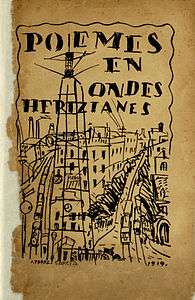 Poemes en ondes hertzianes
Poemes en ondes hertzianes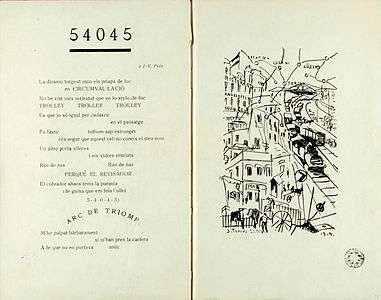
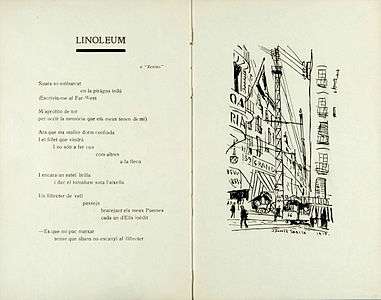 Linòleum
Linòleum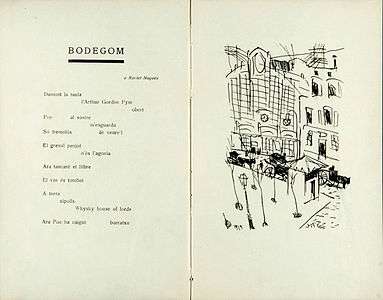 Bodegom
Bodegom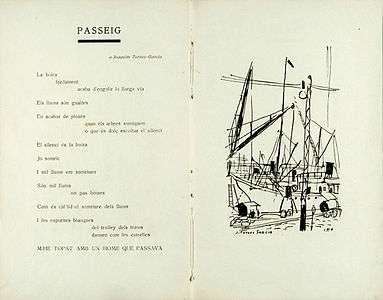 Passeig
Passeig Interior-Salvat
Interior-Salvat
Paintings 1918-1943
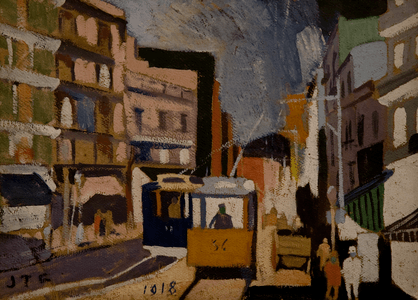 Paisaje de ciudad
Paisaje de ciudad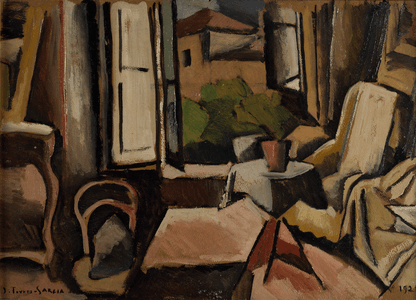 Interior
Interior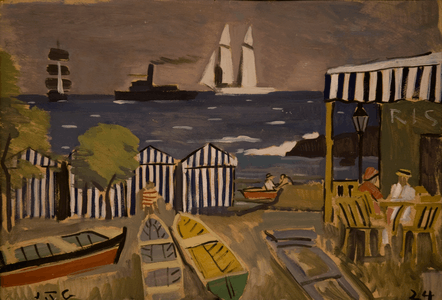 Paisaje de playa
Paisaje de playa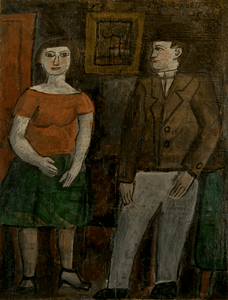 Figuras
Figuras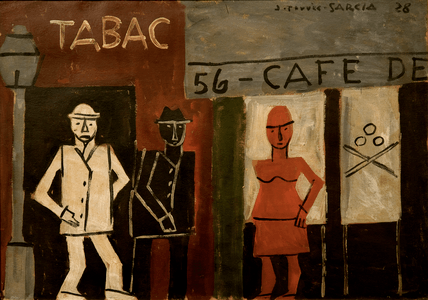 Pintura
Pintura Pintura constructiva 5
Pintura constructiva 5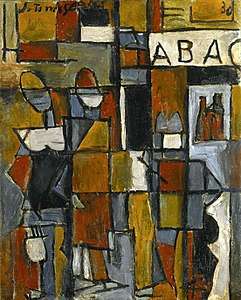 Figuras sobre uma estrutura
Figuras sobre uma estrutura
1930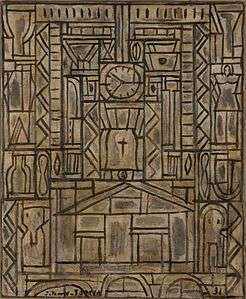 Contraste
Contraste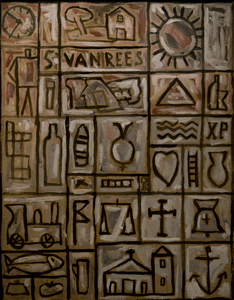 Pintura constructiva 2
Pintura constructiva 2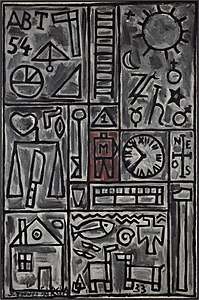
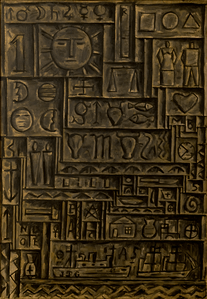 Arte universal
Arte universal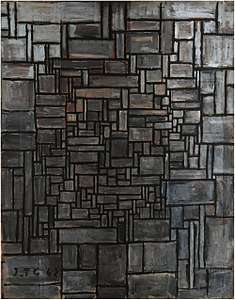 Arte constructivo
Arte constructivo
Monumento Cosmico, 1938
Selected Writings
- Augusta et Augusta, Barcelona, Universitat Catalana, 1904
- Dibujo educativo en el colegio Mont D'Or, Barcelona, 1907
- Notes sobre Art, Barcelona, 1913
- Diàlegs, 1914
- Descubrimiento de sí mismo, 1914
- Consells als artistes, Barcelona, Un enemic del poble, 1917
- Em digué tot aixó, Barcelona, La Revista, 1917
- D'altra orbita, Barcelona, Un enemic del poble, 1917
- Devem Caminar, Barcelona, Un enemic del poble, 1917
- Art-Evolució, Barcelona, Un enemic del poble, 1917
- El Públic i les noves tendéncies d'art, Barcelona, Velli nou, 1918
- Plasticisme, Barcelona, Un Enemic del poble, 1918
- Natura i Art, Barcelona, Un Enemic del poble, 1918
- L'Art en relació al home etern i l'home que passa, Sitges, Imprenta El eco de Sitges. 1919
- La Regeneració de si mateix, Barcelona, Salvat Papasseit Editor, 1919
- Foi, París, 1930
- Ce que je sais, et ce que je fais par moi-même, Losones, Suiza, 1930
- Pére soleil, París, Fundación Torres García, 1931
- Raison et nature, Ediciones Imán, París, 1932
- Estructura, Montevideo, 1935
- De la tradición andina: Arte precolombino, Montevideo, Círculo y cuadrado, 1936
- Manifiesto 2: Constructivo 100 %, Montevideo, Asociación de Arte Constructivo, 1938
- La tradición del hombre abstracto (Doctrina constructivista). Montevideo, 1938
- Historia de mi vida. Montevideo, 1939
- Metafísica de la prehistoria indoamericana, Montevideo, Asociación de Arte Constructivo, 1939
- Manifiesto 3, Montevideo, Asociación de Arte Constructivo, 1940
- La ciudad sin nombre. Montevideo, Uruguay, Asociación de Arte Constructivo, 1942
- Universalismo Constructivo, Montevideo, 1944
- Con respecto a una futura creación literaria y dos poemas, Divertimento 1 y Divertimento 11, Montevideo, Revista Arturo, 1944
- La decoración mural del pabellón Martirené de la colonia Saint Bois. Montevideo, Gráficas Sur, 1944
- En defensa de las expressiones modernas del arte, Montevideo, 1944
- Nueva escuela de arte de Uruguay. Montevideo, Asociación de Arte Constructivo, 1946
- La regla abstracta. Montevideo, Asociación de Arte Constructivo, 1946
- Mística de la pintura, Montevideo, 1947
- Lo aparente y lo concreto en el arte, Montevideo, 1948
- La recuperación del objeto, Montevideo, 1948
Selected paintings
- La colada, oil on canvas, 1903
- La casa del lavadero, oil on canvas on wood, 1903, Museo Abadía de Montserrat. Barcelona.
- El pintor con su familia1917
- Construction in White and Black at the Museum of Modern Art (1938)
- Constructive City with Universal Man
- Composition
Murals
- Wall decoration of the Chapel of Blessed Sacrament and Montserrat of the Church of San Agustín, Barcelona, 1904
- Decoración mural del ábside de la iglesia de la Divina Pastora, Sarriá, Barcelona, 1906
- Decoración mural del despacho de Hienda del Ayuntamiento de Barcelona. Barcelona, 1908
- Decoración mural del pabellón del Uruguay en la exposición universal con las alegorías Ganadería y Agricultura, Bruselas, 1910
- Palas introduciendo a la Filosofía en el Helikon como Xª Musa, Barcelona, 1911
- La Cataluña eterna, decoración mural del salón San Jorge, Palacio de la Generalitat, Barcelona, 1915
- La edad de oro de la humanidad, decoración mural del salón San Jorge, Palacio de la Generalidad, Barcelona, 1915
- Las musas o Las artes, decoración mural del salón San Jorge, Palacio de la Generalidad, Barcelona, 1916
- Lo temporal no es más que símbolo, decoración mural del salón San Jorge, Palacio de la Generalidad, Barcelona, 1916
- Decoración mural de Mon Repós, Tarrasa, Barcelona, 1915
- Decoración mural del domicilio Badiella, Tarrasa, Barcelona, 1916
- Maternidad, Clínica del Doctor Rodríguez López, Montevideo, 1944
- Forma, Decoración mural constructiva, pabellón Martirené del Hospital de Saint Bois, Montevideo, 1944
- El pez, Decoración mural constructiva, pabellón Martirené del Hospital de Saint Bois, Montevideo, 1944
- Pax in lucem, Decorsion mural constructiva, pabellón Martirené del Hospital de Saint Bois, Montevideo, 1944
- El tranvía, Decoración mural constructiva, pabellón Martirené del Hospital de Saint Bois, Montevideo, 1944
- El sol, Decoración mural constructiva, pabellón Martirené del Hospital de Saint Bois, Montevideo, 1944
- Locomotora Blanca, Decoración mural constructiva, pabellón Martirené del Hospital de Saint Bois, Montevideo, 1944
- Pachamama, Decoración mural constructiva, pabellón Martirené del Hospital de Saint Bois, Montevideo, 1944
Major exhibitions
- 25 October 2015 – 15 February 2016, Joaquín Torres-García : the Arcadian modern, Museum of Modern Art, New York, US.
- 29 December 2013 – 2 March 2014, Art & Textiles: fabric as material and concept in modern art from Klimt to the present, Kunstmuseum, Wolfsburg, Germany.
- 22 Apr 2013 – 30 Jun 2013, From Picasso to Barceló. Spanish Sculpture of the 20th Century, National Art Museum of China, NAMOC.
- 16 May – 11 September 2011, Torres-García a les seves cruïlles (Torres-García at his Crossroads), Museu Nacional d'Art de Catalunya (MNAC), Barcelona, Spain.
- 27 March 2009, Trazos de Nueva York, Museo Torres-Garcia, Montevideo.
- December, 2008 - April 2009, Torres García a Vieira da Silva, 1929–1949, IVAM, Valencia, Museu Colecção Berardo, Portugal.
- 8 October 2005 – 15 February 2006, Le feu sous les cendres : de Picasso à Basquiat, Fondation Dina Vierny-Musée Maillol, Paris.
- 7 October 2005 – 19 February 2006, Obras maestras del siglo XX en las colecciones del IVAM, Valencia.
- 25 November 2003 – 11 April 2004, Torres-Garcia, Museu Picasso, Barcelona.
- 2003, Jean-Michel Basquiat - Gaston Chaissac - Jean Dubuffet - Joaquin Torres-Garcia, Jan Krugier Gallery, New York.
- September 2002, From Puvis De Chavannes to Matisse and Picasso : Toward Modern Art, Palazzo Grassi, Venice.
- 24 May – 8 September 2002 - Joaquin Torres-Garcia : un monde construit : Musée d'art moderne et contemporain, Strasbourg
- 31 May – 23 August 1992 - Joaquin Torres-Garcia en Theo van Doesburg, The Stedelijk Museum, Amsterdam.
Bibliography
- Joaquim Torres i García; Estherde Cáceres, Carmelo de Arzadum, Alfredo Cáceres, Pablo Purriel, Juan R. Menchaca, i Guido Castillo, the decoration mural of the Martirené pavilion of the colony Saint Bois. Murals paintings of pavilion J.J. Martirené Hospital of the colony Saint Bois. South graphs. Montevideo, 1944.
- Claude Schaefer, Joaquin Torres García. Ed. Poseidón. Library Argentina de Arte. Buenos Aires, 1949.
- Josep Francesc Ràfols, biographical Dictionary of artists of Catalonia. Torres-Garcia, Joaquin, Volume III, p. 153. Barcelona, Milà, 1966.
- Daniel Robbins, Joaquin Torrers-Garcia, 1874–1949. Ed. by Museum of Art Rhode Island School of Design. Providence, 1970. ISBN 0-911517-23-5
- Enric Jardí, Torres García. Editorial Polígrafa, S. A., Balmes, 54 – 08007, Barcelona, 1973. ISBN 84-343-0180-6
- Jacques Lassaigne, Ángel Kalenberg, Maria Helena Vieira da Silva, Michel Seuphor, Jean Hélion, Torres-Garcia. Construction et Symbols. Published by the Museum of Modern Art of Villa of Paris. Catalogue of the exhibition made between June and August 1975. Paris, 1975.
- Jacques Lassaigne, Torres-Garcia. Works destroyed in the fire of the museum of modern art of Rio de Janeiro, Published by the Torres Foundation Garci'a. Montevideo, Uruguay. 1981.
- Margit Rowell, Theo van Doesburg, Joaquín Torres-García, Torres Garcia Structure. Paris-Montevideo 1924–1944 Edited by Foundation Joan Miró. Catalogue of the exhibition in the Fundació Joan Miró, Parc de Montjuic in March 1986. Barcelona, 1986.
- Ángel Kalenberg, Seis Maestros De La Pintura Uruguaya: Juan Manuel Blanes, Carlos Federico Saez, Pedro Figari, Joaquin Torres García, Rafael Barradas y José Cúneo. Edited by Museo Nacional de Bellas Artes de Buenos Aires. Catálogo de la exposición realizada entre Septiembre y Octubre de 1987. Avda. del Libertador, 1473. Buenos Aires, 1987. Printed in Montevideo, 1987.
- Alicia Haber, Joaquin Torres Garci'a. Eternal Catalonia. Sketches and drawings for the fresh airs of the Delegation of Barcelona. Edited by Foundation Torres Garci'a. Montevideo. Uruguay, 1988.
- María Jesús García Puig, Joaquin Torres Garcia and the Constructive Universalismo: The education of the art in Uruguay. Editions of Hispanic culture. Collection Art. Madrid, 1990. ISBN 84-7232-558-X
- Jorge Castle, Nicolette Gast, Eduardo Lipschutz-Villa, and Sebastián López, The antagonistic Link. Joaquin Torres Garcia-Theo van Doesburg. Published by Institute of Contemporary Art. Ámsterdam, 1991.
- Pilar Garcia-Sedas, Joaquin Torres the Striped Garcias and Rafael. Dialeg escrit: 1918–1928. Publicacions of l' Abbey of Montserrat. Barcelona, 1994. ISBN 84-7826-531-7
- Joan Sureda Pons, Narcís [Narciso], Comadira and Mercedes Doñate, Torres Garcia: Pintures de Mon Repos, Published by the Museum of modern Art of the Museum of Art of Catalunya and the Caixa of Terrassa. I catalogue of the exhibition that place in the museum of modern art of the MNAC took, and in the Cultural Foundation of the Caixa of Terrassa. Barcelona, January 1995.
- Pilar García-Sedas, Joaquim Torres Garcia. Epistolari Català: 1909–1936. Curial Edicions Catalan. Publicacions of l' Abbey of Montserrat, Barcelona, 1997. ISBN 84-7826-839-1
- Joan Sureda Pons,, Torres Garcia. Classic passion. Akal editions/contemporary Art. Number 5. Madrid, 1998. ISBN 84-460-0814-9
- Carlos Pérez, Pilar Garcia-Sedas, Mario H. Gradowczyk and Emilio Ellena, Aladdin Toys. Them joguines of Torres Garcia. Published by the IVAM. I catalogue of the exhibition that took place in the Valencian Institute of Modern Art in September 1998.
- Miguel Angel Battegazzore, the plot and the signs, Impresora Gordon, S.A. Av. General Rondeau 2485, Montevideo, 1999.
- Gabriel Peluffo Linari, History of the Uruguayan painting. Editions of Eastern band limited liability company. Gaboto 1582. Montevideo 11200. Uruguay, 1999 imaginary Tomo the 1 National-regional (1830–1930) from Blanes to Figari Tomo 2 Between localismo and universalismo: Representations of modernity (1930–1960).
- Michael Peppiatt , Jean-Michel Basquiat - Gaston Chaissac - Jean Dubuffet - Joaquin Torres-Garcia, New York, catalogue of the exhibition that took place in Jan Krugier Gallery, 2003.
- Tomàs Llorens, Emmanuel Guigon, J.Torres-Garcia Un monde construit, Hazan, Strasbourg, 2002, catalogue of the exhibition that took place in Musée d'Art Moderne et Contemporain de Strasbourg, 24 May to September 2002. ISBN 2-85025-827-X
- Tomàs Llorens, Emmanuel Guigon, Juan José Lahuerta, J. Torres-Garcia, Editorial Ausa y Institut de Cultura de Barcelona, Barcelona, 2003, catalogue of the exhibition that took place in Museo Picasso de Barcelona, 25 November to 11 April 2004. ISBN 84-88810-63-6
- Nicolás Arocena Armas, Eric Corne, Marina Bairrão, Emmanuel Guigon, Domitille D'Orgeval, La ituicion y la Estructura, Lisboa, Museo Coleccao Berardo, 2008. ISBN 978-84-482-5105-5
- Tomás Llorens, Nicolás Arocena Armas, Torres-Garcia a les seves cruilles-Torres-Garcia en sus encrucijadas. Barcelona, Spain: Museu Nacional d'Art de Catalunya 2011.
- Llorens, Tomas. Arocena Armas, Nicolas, J.Torres-Garcia, New York, Joaquin Torres-Garcia Archive, 2011. Notes
Notes
- ↑ Lassaigne, Jacques (1975). Torres-Garcia Constructions et Symbols. Paris: Musee d'art de la Ville de Paris. p. 8.
- ↑ Cotter, Holland. "An Avant-Gardist Who Bridged the Archaic and the New". The New York Times. The New York Times. Retrieved 1 November 2015.
- 1 2 3 4 Llorens, Tomàs (May 2011). Torres-Garcia a les seves cruilles-Torres-Garcia en sus encrucijadas. Barcelona, Spain: Museu Nacional d'Art de Catalunya. p. 18. ISBN 978-84-8043-232-0.
- ↑ Coll Tomas, Baltasar (1977). Catedral de Mallorca. Palma de Mallorca: Museo Capitular. p. 43. ISBN 84-400-3133-5.
- ↑ Torres-Garcia, Joaquin (1939). Historia de mi vida. Montevideo: Publicaciones de la Asociacion de Arte Constructivo. p. 95.
- ↑ "El Palau de la Generalitat, seu de la Presidència, Sala 16, Sala de Torres-Garcia". Generalitat de Catalunya. Archived from the original on 24 September 2015.
- ↑ "Artist". Joaquin Torres-Garcia Archive.
- ↑ "Cercle et Carre art group". Encyclopædia Britannica. Encyclopædia Britannica Inc. Retrieved 8 October 2015.
- 1 2 3 4 Robbins, Daniel (1970). Joaquin Torres-Garcia 1874–1949. Providence: Museum of Art, Rhode Island School of Design.
- 1 2 Schaefer, Claude (1949). Joaquin Torres-Garcia. Buenos Aires: Editorial Poseidon.
- ↑ Doyle Duncan, Barbara (1971). Joaquin Torres-Garcia. 1: University of Texas.
- ↑ Roca, Alfons (2012). El Palau de la Generalitat de Catalunya Resum de 600 anys d'art. Barcelona: Generalitat de Catalunya. p. 22.
- ↑ Surio, Dario (1965). Torres-Garcia Memorial Exhibition. New York: Rose Fried Gallery.
- ↑ Llorens, Tomas (2011). J. Torres-Garcia. New York: Joaquin Torres-Garcia Archive.
- ↑ Utrillo, Miguel. "Joaquin Torres-Garcia, Decorator". Pèl i Ploma No. 74
- ↑ Armas Arocena, Nicolas (2008). Torres-Garcia Pythagoras – Plato: A Geometric Dialogue, or The Eye of the Soul. Lisbon: Museo Coleccao Berardo. ISBN 978-84-482-5105-5.
- ↑ Sureda Pons, Joan (1998). Torres-Garcia, Pasion Clasica. Madrid: Ediciones Akal.
- ↑ Josep Palau i Fabre, Picasso a Catalunya, Edicions Polígrafa, S.A., Barcelona, 1975, p. 196
- ↑ Exposició de dibuixos i pintures de Joaquim Torres García, Galeries Dalmau, 1912 (exhibition catalogue)
- ↑ Picasso, Veu de Catalunya, 7 March 1912
- ↑ Marquina, Eduardo (1933). J. Torres-Garcia. Madrid. p. 4.
- ↑ Wheeler, Monroe (1971). Joaquin Torres-Garcia. University Art Museum University of Texas at Austin. p. 3.
- ↑ Roca, Alfons (2012). El Palau de la Generalitat de Catalunya Resum de 600 anys d'art (PDF). Barcelona: Generalitat de Catalunya. p. 22. Archived from the original (PDF) on 6 October 2015.
- ↑ Woodcut invitation by artist dated 1915. ill. Eric Jardi 1973
- ↑ Penelo, Lidia (17 May 2011). "Las encrucijadas de Torres-García llegan al MNAC". Publico.
- 1 2 Roe, Jeremy (2011). "Creative Forks". Apollo.
- ↑ Molins, Javier (2003). Grandes Artistas: La mirada de los descendientes. Valencia: IVAM Institut Valencia d'Art Modern. p. 56. ISBN 84-482-3564-9.
- 1 2 Lidia Penelo. "Las encrucijadas de Torres-García llegan al MNAC". publico.es. Retrieved September 29, 2017.
- 1 2 3 4 5 Arocena Armas, Nicolas (2011). Torres-Garcia a les seves cruilles-Torres-Garcia en sus encrucijadas. Barcelona: Museu Nacional d'Art de Catalunya. p. 232. ISBN 978-84-8043-232-0.
- ↑ Annual exhibition of painting and sculpture by members of the Club, New York, N.Y., Whitney Studio Club, 1922
- ↑ "Joaquín Torres-García (1874–1949) One Man, Three Continents". Joaquín Torres-García Archive. Retrieved 5 October 2015.
- ↑ Catàleg de l'Exposició de Joaquim Torres García, organitzada a les Galeries Dalmau del Passeig de Gràcia, del 12 al 25 de juny 1926 Barcelona
- ↑ Juan de Gary. Mai 1926 Excerpt from the catalog of the exhibition at Galeri A.G. Fabre 20 Rue de Miromesnil du 7 au 20 de Juin 1926. Translated from French
- ↑ Catàleg de l'Exposició de Joaquim Torres García, organitzada a la Galerie Carmine, del 16 al 30 de juny. París. Pròleg de Joseph Milbauer
- 1 2 Llorens, Tomas (2003). Torres-Garcia. Editorial Ausa. p. 255. ISBN 84-88810-63-6.
- ↑ "Expositions". Esprit Francais. 15 November 1931.
References
- Arocena Armas, Nicolas. Torres-Garcia- Pythagoras- Plato A Geometric Dialogue, or the Eye of the Soul, Lisboa, Museo Coleccao Berardo, 2008
- Arocena Armas, Nicolas. Biography. Torres-Garcia a les seves cruilles-Torres-Garcia en sus encrucijadas. Barcelona, Spain: Museu Nacional d'Art de Catalunya 2011.
- Llorens, Tomas.Torres-Garcia a les seves cruilles-Torres-Garcia en sus encrucijadas. Barcelona, Spain: Museu Nacional d'Art de Catalunya 2011
- Llorens, Tomas. J.Torres-Garcia, New York, Joaquin Torres-Garcia Archive, 2011.
- Llorens,Tomas. Torres-Garcia. Editorial Ausa, 2003
- Robbins, Daniel. Joaquin Torres-Garcia 1874–1949. Providence, Museum of Art Rhode Island School of Design, 1970
- Rafols, F. Josep, Torres-Garcia, Barcelano, 1926.
- Schaefer, Claude. Joaquin Torres-Garcia. Buenos Aires, Editorial Poseidon, 1949.
- Sureda Pons, Joan. Torres-Garcia, Pasion Clasica. Madrid, Ediciones Akal, 1998
- Surio, Dario. Torres-Garcia. Rose Fried Gallery, New York, 1965
- Torres-Garcia, Joaquin. Historia de mi vida. Montevideo, Ediciones Asociacion Arte Constructivo, 1939.
External links
| Wikimedia Commons has media related to Joaquín Torres García. |
- Archive Joaquin Torres-Garcia
- http://www.philamuseum.org
- National Gallery of Art
- http://www.guggenheim.org
- Museo Centro de Arte Reina Sofia
- Museo Thyssen-Bornemisza
- Albright-Knox Art Gallery
- Rhode Island School of Design Museum
- Smithsonian Archives of American Art
- Museo Torres García – Montevideo
- LACMA
- Joaquin Torres Garcia, Museum of Modern Art
- Metropolitan Museum of Art
- http://www.musee-lam.fr/
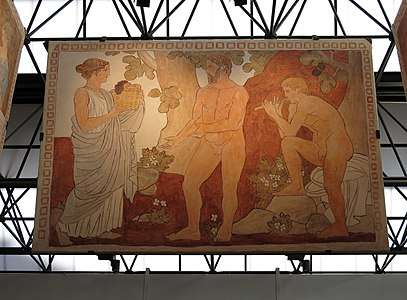
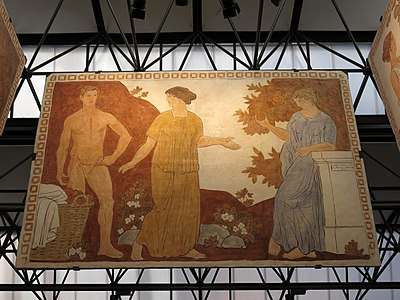
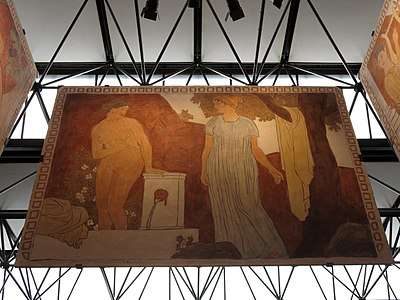
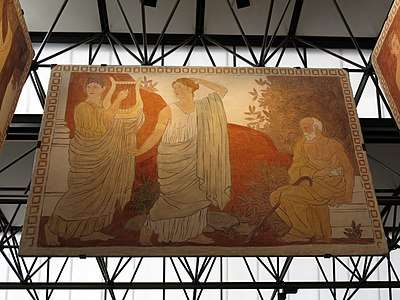

_-_6.jpg)
_-_3.jpg)
